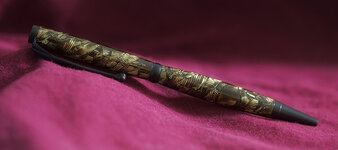keithncsu
Member
Looking for a little help/wisdom/historical info. 1-2 years ago I made a pen from some vintage cellulose acetate and it turned out great. One of my favorite pens and I never intended to part with it. Problem is I have a family member who loves it and wants to purchase it as a gift for their boss. She knows it is a rare material and wants me to write up something to give with the pen explaining it.
That leads me here. I know it is a vintage material from the 20s-30s and that it is no longer produced and therefore rare. But outside of that, what else is there? Why did it become rare? Was it that new technology/materials/processes came along that made a better/cheaper/more durable product? Being that I never intended to have to explain it, I never really looked into the details. I just loved the look of the blank and made myself a pen. That was the extent of it for me.
Any info the wisdom of the minds here could shed would be great appreciated!
Thanks,
That leads me here. I know it is a vintage material from the 20s-30s and that it is no longer produced and therefore rare. But outside of that, what else is there? Why did it become rare? Was it that new technology/materials/processes came along that made a better/cheaper/more durable product? Being that I never intended to have to explain it, I never really looked into the details. I just loved the look of the blank and made myself a pen. That was the extent of it for me.
Any info the wisdom of the minds here could shed would be great appreciated!
Thanks,

